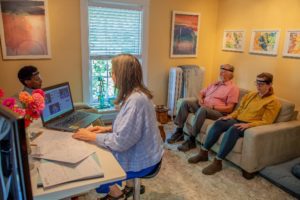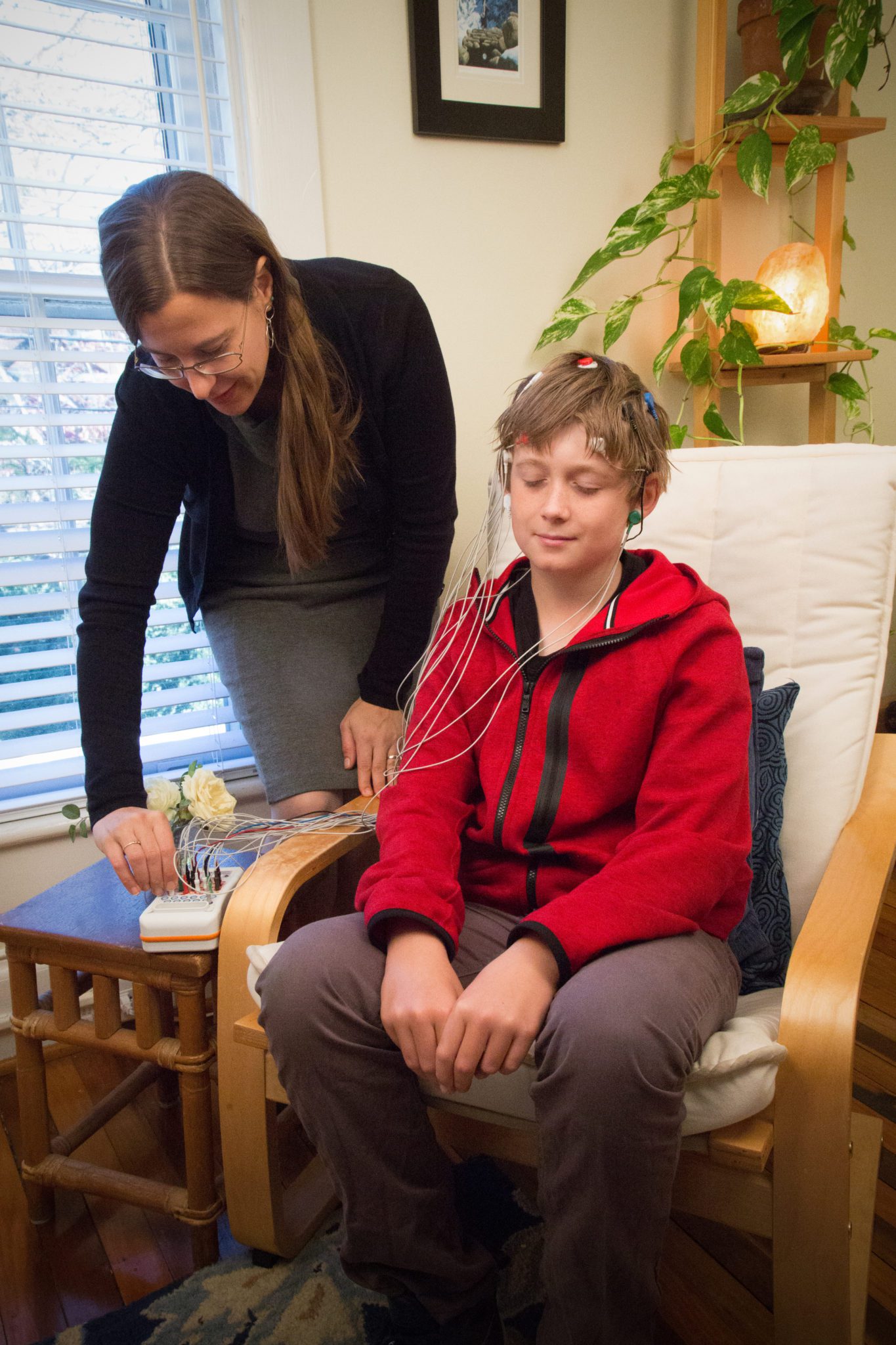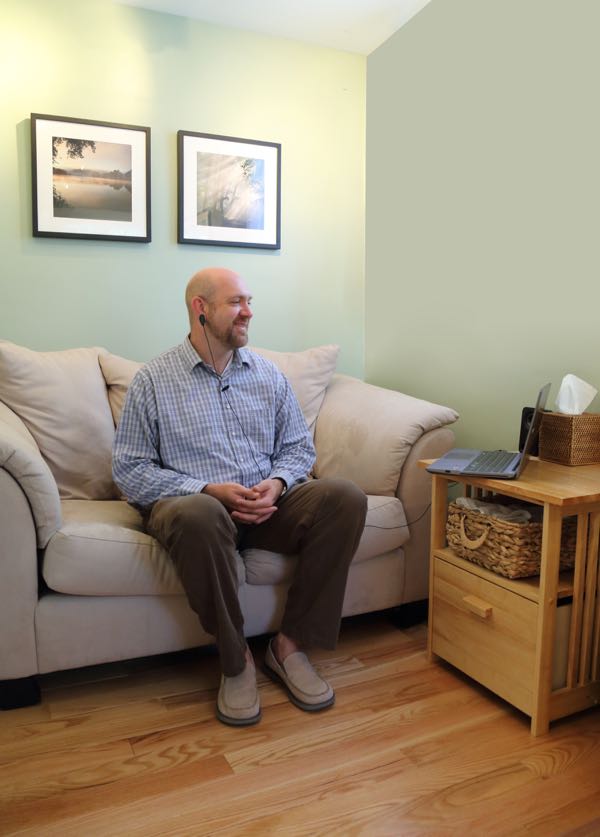Our Services
About Neurofeedback
Neurofeedback is a type of biofeedback that measures and trains brain waves. Results are achieved by teaching the brain to change using feedback. During a session, the brain receives real-time audio/visual information that reflects it’s own electrical activity. This ‘brain training’ produces more efficient, balanced and stable neural patterns. In her book about neurofeedback and developmental trauma, Sebern Fisher states that ‘neurofeedback raises the brain’s threshold to stress and generally increases stress resilience as it increases stability.
We’re offering neurofeedback home training, allowing you to run your sessions at home, while being supported and monitored by our team. This is the most affordable neurofeedback option.
blank
How does neurofeedback work?
An EEG machine measures the electrical energy released by nerve cells at work. The numbers of brain cells firing at different speeds produce the brainwave patterns seen on the EEG. The brainwaves have names, but in general, the speedier brainwaves are used for thinking while the slower ones are used for relaxation and to maintain involuntary bodily functions. Neurofeedback allows us to regulate our brainwave patterns.
Neurofeedback encourages specific areas of the brain to speed up or slow down as needed, essentially stabilizing brain activity. Neurofeedback training encourages flexible and adaptive brain wave communication that results in the experience of moving more smoothly from one state of arousal to another. Eventually, no more training is required to maintain improved these benefits.
What issues does neurofeedback address?
The following issues have published scientific evidence of effectiveness with Neurofeedback:
Addiction
Anxiety
ADHD/ADD
Depression
Learning Disabilities
Post-Traumatic Stress Disorder
Relaxation
Sleep Disorders
The following issues have clinical reports of effectiveness with Neurofeedback:
Attachment Disorder
Autoimmune Dysfunction
Chronic Fatigue Syndrome
Chronic Pain
Borderline Personality Disorder
Cognitive Decline in the Elderly
Eating Disorder
Obsessive-Compulsive Disorder
Tourette’s Syndrome
Traumatic Brain Injury
Dissociative Identity Disorder
Parkinson’s Disease
blank
What will I experience?
During a neurofeedback session, you may receive as little as 30 seconds or as much as one hour of training depending upon your brain’s receptivity. Sometimes you may be an active participant in changing your brain wave pattern but often the feedback will allow your brain to change itself without any effort on your part. In our clinic, typically 35-40 sessions of neurofeedback constitutes a complete training program. However, the length of treatment at our clinic varies widely. People who have a traumatic brain injury, degenerative neurological condition or complex trauma history may expect to continue treatment much longer than 40 sessions in order to maintain an improved level of functioning.
About Lens
blank
How does Lens works?
What will I experience?
The side effects we have seen following LENS are minimal. A few clients have reported mild to moderate headaches and some sleepiness. While the LENS results in successful treatment for many, there is no guarantee that it will help everyone.
How Many sessions will i need?
If you are more sensitive or have a history of complicated or chronic problems, you may need more than 20 sessions. It has been our experience that people with complex developmental trauma may need a few years of LENS treatment in combination with other modalities in order to fully benefit.
About AWAKENED MIND MEDITATION GROUPS
What is the Awakened Mind (AM)?
Our meditation groups teach the pathway to a state of consciousness called The Awakened Mind. Sometimes people refer to this state as “being in the flow” or “peak performance”. One might experience clarity of mind, enhanced sensory awareness and neuromuscular coordination, creativity, insight, feelings associated with spirituality, increased compassion, empathy and/or psychic awareness. Once you understand how to find The Awakened Mind, you may use the pattern to obtain personal insight through your own process of self-inquiry and creative problem-solving. To learn more about the Awakened Mind, Click Here to go to the Institute for the Awakened Mind’s website.
blank
Why participate in an AM meditation group?
Life in the digital age leaves many of us feeling frazzled. The deluge of information encourages multi-tasking as we struggle to balance home and work. Our fast-paced lifestyle leads to overstimulation making it hard to slow down and to rest deeply. In addition, many with difficult childhoods or traumatic experiences develop an upregulated nervous system for self-protection. Strategies to defend against fear/terror may even make relaxation feel dangerous. The Mind Mirror Groups at Virginia Neurofeedback create a safe non-judgmental atmosphere to learn meditation with the additional benefit of brain wave monitoring.
The Awakened Mind Meditation program will help you understand the depth and breadth of your meditation by linking your brain wave measurements for each meditation to your in-the-moment subjective experience. Then, with Robin’s feedback and Mind Mirror brain wave reports you will be guided to explore a wide range of meditation experiences. Since 1976, well over 15,000 people learned about meditation using the Mind Mirror biofeedback and neurofeedback program. For history about the development of the Mind Mirror, click here.

A small group recording brain waves while following a guided meditation.
What is a meditation session like?
Each small group session is limited to 4 people using brain wave monitoring and lasts approximately 90 minutes. Two sensors are placed at the back of the head and two are placed just above and behind the ears and a sensor is placed on the upper back. Wires lead from these sensors to a device that measures your brain waves during the entire pre-recorded guided meditation which last 20-40 minutes. After the meditation, you will record your personal experience through your own written summaries and your brain wave patterns will be uploaded to the Mind Mirror Portal where they may be reviewed by participants later. For more information about the Mind Mirror Portal, click here.
ABOUT THE HARDWARE AND MIND MIRROR 6 SOFTWARE
The Mind Mirror 6 Software and Vilistus Hardware Create a Powerful Educational and Research Tool
Judith Pennington, founder of the Institute for the Awakened Mind (IAM) and the co-developer of the Vilistus Mind Mirror 6 EEG (electroencephalograph), has created a research tool to explore states of consciousness with integrated sensors for 2-channel EEG, galvanic skin response (GSR), heart rate variability (HRV) and skin temperature. One Vilistus amplifier can also measure simultaneous EEG recordings of 4 people and synchronize the language of guided meditations to the EEG in real time. This incredible advance in EEG monitoring allows clinicians, researchers and even home-trainers, to pinpoint to the second a brain wave pattern associated with a specific subjective shift in awareness. For more information about the Vilistus Mind Mirror 6, click here.
This equipment is available for purchase and home-training. If you are interested in a practitioner’s kit, please click here.
Recommended Reading for Mind Mirror Meditation Groups:
Goleman, Daniel and Davidson, Richard. Altered Traits: Science Reveals How Meditation Changes Your Mind, Brain and Body. Avery (2017)
Wise, Anna. The High-Performance Mind: Mastering Brainwaves for Insight, Healing, and Creativity.
Tarcher Perigee (1997).
Wise, Anna. Awakening the Mind: A Guide to Harnessing the Power of Your Brainwaves. Tarcher Perigee (2002).
Young, Shinzen. The Science of Enlightenment: How Meditation Works. Post-Hypnotic Press, Inc. (Audiobook 2018).
About QEEG
blank
What is it like to have a QEEG?
The conductive gel must soak down through the hair to the skin in order to relay the brainwave activity to the sensors in the cap. Rarely, but occasionally, people who are very sensitive to touch find this process mildly uncomfortable. Most people easily tolerate the process.
During the EEG recording it is important to sit still and remain as relaxed as possible. It is not necessary to remain this way for more than a few minutes at a time. We can stop and take breaks as needed.
After recording the EEG for 10 minutes with eyes closed and eyes open, the cap is removed and the gel is cleaned off. It is likely you will want to plan to go home and wash your hair when the process is completed.
Please follow the below instructions to be prepared.
What is the cost of QEEG?
Preparation Instructions for the QEEG
BE AS RESTED AS POSSIBLE
Try to be as well rested and alert as possible prior to the EEG. If you unusually tired (for you), the EEG acquisition should not be done. Please contact your clinician before the appointment if you are feeling extremely tired or sleepy that day and we will reschedule.
CLEAN, DRY HAIR
The day before or the day of the test, thoroughly shampoo your hair TWO times. Be sure to scrub your entire scalp, forehead, and earlobes with your fingertips, rinse your hair thoroughly between and after washing. Hair must be thoroughly dry for the EEG.
NO HAIR PRODUCT
Do not apply hair conditioner, mousse, gel, or hair spray, and keep your forehead free of make-up, lotions, and conditioners. In addition, do not braid your hair or wear earrings.
NO STIMULANTS
Please do not use stimulants the day of the test. Examples are: coffee, tea, cigarettes, caffeinated soft drinks, etc. Also, avoid illegal or over-the-counter drugs, foods, herbs, or herbal teas that promote sleep/relaxation or the awake/alert state on the day of the EEG.
NO CONTACTS
Do not wear contact lenses as they may become uncomfortable thereby causing EEG artifact which disrupts the acquisition of good EEG data.
MEDICATIONS
Prior to scheduling the QEEG, we will gather a detailed medication history from you and consult with your prescribing doctor as needed. We do not manage medications or make suggestions related to your medications. Do NOT make any decisions about stopping medications without first consulting with the physician who prescribed them. The QEEG can be performed regardless of your prescriptions, but it is important that we document your current medications in order to take into consideration their effect on the results.

About hrv
Heart Rate Variability (HRV) training is offered as an adjunct to treatment at the Virginia Center for Neurofeedback, Attachment & Trauma. Clients participate in biofeedback and breathing exercises that help to relieve stress, reduce anxiety, and enhance the ability to learn new information. The heart rhythm has a significant effect on brain function.
blank
How does HRV training work?
What symptoms does HRV training address?






 Follow us
Follow us